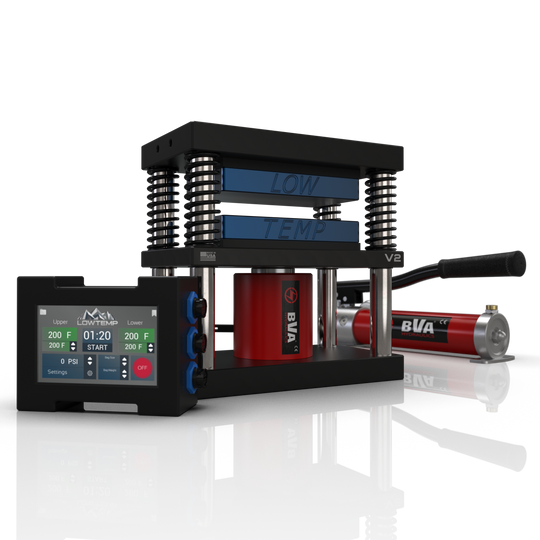What Is Rosin & Why Is It a Popular Extract Product?

Rosin is a type of cannabis concentrate that's made by mechanically pressing ice water hash, dry sift, or flower between two heated plates to squeeze the resinous oil out of the trichome heads. After pressing, the rosin can be refined even further for use in dabbing, vaping, and twaxing applications.
Because no solvents are used in the rosin pressing process, rosin is commonly referred to as solventless hash oil (SHO) to differentiate it from butane hash oil or butane honey oil (BHO). SHO is a great option for growers and processors who are interested in creating clean, top-end concentrates that sell at a premium price point, and also for cannabis enthusiasts who want to experiment with solventless extraction at home.
Types of Rosin
Rosin can be classified by its starting material and also by the consistency of the end product.
Flower Rosin
Flower rosin is created by squishing dried and cured plant material directly in a rosin press—either with or without a rosin bag. This is one of the most popular products with home extractors because it's easy and quick and can be done with minimal equipment.
From a commercial point of view, cannabis flower rosin is mostly useful for re-pressing into THCa isolate or for infusing into a carrier oil for edibles. Dry sift rosin and ice water hash rosin are more desirable as far as dabbing and vaping go.
Dry Sift Rosin
Dry sift rosin is pressed from refined kief—the pollen that's separated from cannabis plant matter by sifting the trichomes through a graduated series of mesh screens. The quality of dry sift rosin is completely at the mercy of the form of extraction, the material used, and the processor/equipment. It can vary from extremely high-end 6-star melt to a nasty 10% yield of black/brown rosin.
Dry sift hash is notorious for looking blonde and full of resin, but when thrown inside of a rosin press, the rosin can come out very dark and/or have a low yield. It’s important to remember that the process of rosin pressing is at the mercy of the purity and quality that you start with!
Hash Rosin
Hash rosin is rosin pressed from ice water hash (AKA bubble hash). This is considered the gold standard in solventless extraction because hash rosin is incredibly pure and can have upwards of 85% THC.
If you wash fresh frozen cannabis flowers and press the live bubble hash at cool temperatures, you can create live rosin—an extract that reflects the full terpene profile of the plant when it was cut. In the eyes of discerning cannabis connoisseurs, live rosin is the bee’s knees.
Hemp and CBD Rosin
Rosin that's pressed from hemp is known as hemp rosin or CBD rosin. This cannabis extract is often a dark color and has a sappier consistency than marijuana rosin due to the bulk nature in which hemp is grown and processed, and because its cannabinoid structure differs from that of traditional THC-prominent cannabis oil.
Once pressed, hemp rosin will likely be over the 0.3% of THC by weight that’s allowed by the US Farm Bill, so you can’t transport it across state lines. However, in states where marijuana is legal, hemp rosin can be added to edibles, tinctures, drinks, etc. to give a true full-spectrum CBD extract experience.
Tips for Making Great Hemp/CBD Rosin
If you want to make great hemp/CBD Rosin, it’s recommended you work with the grower before planting to discuss a proper gameplan. The following should be considered:
- The selection of proper genetics. There are some CBD strains that perform extremely well as rosin, and some that would yield almost nothing.
- Cultivation with safe/no pesticides, and ensuring there is no mold or powdery mildew on the plants. This is good practice for any extract, but even more important with mechanical solventless separation.
- Harvesting. We recommend hand harvesting or being gentle with the harvest machinery if possible. Even better: The plants can be harvested and frozen immediately inside of sealed bags in an ideal world.
Rosin Consistencies
With the right starting material, pressing temperature, and post-processing techniques, you can achieve almost all of the popular concentrate textures that are typically made via hydrocarbon extraction.
Rosin can be processed into:
- Badder and budder
- Shatter
- Wax
- Jam
- Sauce and diamonds
- THCa isolate
- Carts
Most of these textures are achieved via the use of cold or hot pressing, cold or warm curing, post-extraction whipping, and other techniques.
Extraction Process
Rosin initially started out as a DIY extract made with a hair straightener, T-shirt press, or even a pair of heated gloves. With further research, development, and testing, companies have now created dedicated commercial rosin presses that take care of the entire process and produce top-quality, consistent results.
To create rosin from bubble hash, dry sift, or cannabis flower with a rosin press:
- Put your dried bubble hash, dry sift, or cannabis flower in a rosin bag using a stainless steel funnel (preferably pre-chilled) and fold over the open end of the bag. We recommend our 25μg mesh filter bags for pressing bubble hash or dry sift and 160μg bags for flower. For very pure extracts like bubble hash, it’s worth double-bagging your material.
- Tuck the folded mesh filter bag inside the folded end of a piece of extra-thick parchment paper and place this parchment paper “sandwich” between the rosin press plates.
- Heat the plates to the desired temperature (see our rosin press temperature guide). For the greatest accuracy, you can use an accessory like our LT3 Heat Controller to measure and correct the heat distribution on the plates. This now comes as a standard option with all of our presses!
- Press the plates together using a pump. This could be a hand pump, hydraulic pump, pneumatic pump, or hybrid pump. We generally recommend a pressure of between 300 to 900 platen PSI for bubble hash and dry sift and up to 4000 platen PSI for flower.
- Once the rosin starts flowing out, you can jar it, whip it (optional), or smoke it right away.
- If jarring the rosin, leave the jars uncapped until the rosin reaches room temperature.
- Once the rosin has cooled, seal the jars and store them in a fridge or freezer, or move on to hot or cold curing to create a wide range of textures.
Why Rosin Is So Popular
After only a handful of years on the market, rosin has maintained its popularity with consumers and industry adoption continues to grow. With ongoing R&D in the solventless space, customers' interest in clean extracts, and a growing number of states legalizing marijuana, we can only expect demand for rosin to increase.
No Solvents Are Used in the Production Process
As rosin is extracted purely with heat and pressure, there is no residual solvent or chemicals in the end product. This makes it much easier and more accessible for processors to get set up, as you won't need a special sub room in the lab or a special license for working with volatile solvents.
From the consumer's perspective, a solventless concentrate is a "clean" and health-conscious choice because they know they won't be inhaling or consuming any butane, propane, or other solvents. Even below threshold levels, solvents can also affect the taste of the concentrate, making rosin even more appealing to connoisseurs who'll happily pay more for an authentic and flavorful cannabis experience.
As solventless extraction doesn’t filter out contaminants like heavy metals and microbes, the starting material also has to be of a very high quality in order for the extract to pass quality testing and make it onto the shelf. With hydrocarbon extraction, customers can never be 100% sure about the quality of the extractor’s starting material.
It Can Be Used to Create a Wide Range of Products
With the right starting material and a few simple adjustments to the pressing temperatures, pressing, times, post-processing, and curing methods used, processors can create a wide range of SKUs from rosin to mirror the variety of solvent-based extracts on the market—and far more simply.
Beyond the typical line-up of wax, shatter, badder, and budder that would typically be used with a dab rig, you can also use rosin to make solventless vape carts and rosin-infused edibles, topicals, and pre-rolls.
It's a Lucrative Business Opportunity
If you're looking to get into the extraction game, rosin production is a smart way to go. Not only are you looking at a lower upfront investment and fewer licensing barriers compared to solvent-based extraction, but the earning potential can be higher as well.
In Q3, 2022, the average retail price for solvent-based live resin in California fell to around $20 per gram due to price compression while the average retail price of rosin remained stable at around $35 per gram. Average retail prices in some states—such as Colorado—are as high as $55 per gram. When sold wholesale, quality rosin typically fetches between $20 and $30 per gram (although this varies by state).
Can You Make Rosin at Home?
If you live in a state where cannabis is legal for medicinal and/or recreational use, you may be able to make rosin at home. This could be an advantage for hobbyists who want to dab or smoke rosin or use it to make their own edibles or topicals.
Keep in mind that:
- Some states allow medical marijuana patients to make solventless extracts for personal use.
- Some states allow any adult aged 21 and above to make solventless extracts at home for personal use.
- All states where cannabis is legal have possession and use limits that will apply to any cannabis concentrate you make.
Generally, adults can make rosin for personal use in legal states but can't sell their extracts to others.
For a low-cost setup, you could try the hair straightener method, although you won't have much control over the temperature or pressure. Alternatively, a small professional rosin press like the 3"x5" Lowtemp Press V2 could be surprisingly accessible and will produce excellent rosin every time as long as you begin with high-quality material. Lowtemp designs and manufactures their rosin presses in the USA, and our presses have been the tool of choice for thousands of hash makers, winning hundreds of awards across the globe.
Rosin Could Be the Future of the Cannabis Industry
It may have started as an amateur pastime, but rosin has emerged in recent years as a premium cannabis extract with a wide range of potential applications. From the home enthusiast's perspective, rosin is an easy way to turn homegrown flower into dabs. For the business owner, it's a potential goldmine.
If you want to try making rosin in a commercial facility or at home, keep in mind that you’ll need to start with trichome-rich, fresh plant matter (fresh frozen or max 1-2 weeks after harvest if dried) and a robust, professional-grade rosin press. Get those things right, experiment with temperatures and pressing times, and you could soon be producing top-shelf artisan rosin.
To learn more and get your own equipment to make your own hash, contact our team at 316-308-7441 or support@lowtemp-plates.com!
Products Mentioned in This Article





